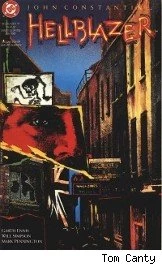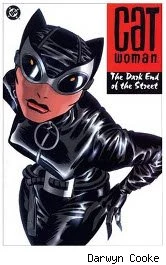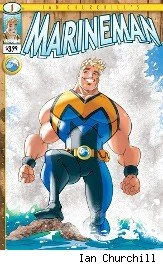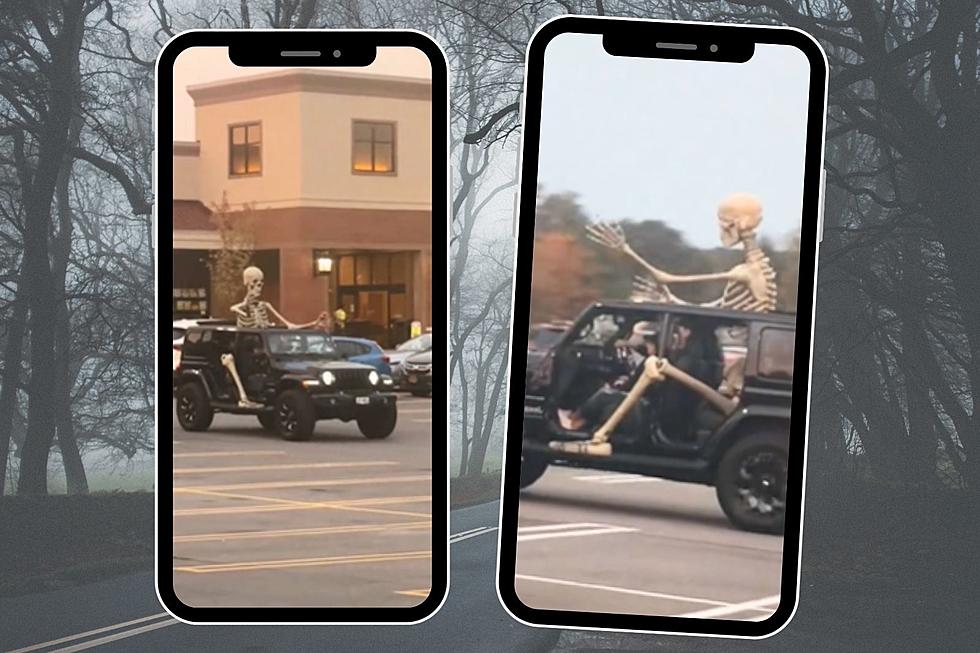
Digital Comics Weekly 04/21/11: Five Comics You Should Be Downloading
Digital comics are exploding onto the market right now. Already, there are thousands to choose from across a number of services. Between ComiXology, Graphic.ly, and Marvel's Digital Comics Unlimited service, you're looking at somewhere between 200 and 300 new digital comics going up every week. There's a lot to sift through -- some of it good, some of it bad -- but ComicsAlliance is here to help, so we'll be picking out five digital comics each week that you should be downloading, with helpful links to each one.
 1. Name: Comic Book Comics
1. Name: Comic Book Comics
Creative Team: Fred Van Lente & Ryan Dunlavey
Platform: ComiXology (Web, iOS, Android)
Price: $0.99 each
Format: Five issues (series download, and a free preview)
Why: Comics history is a hot mess, to put it nicely. It's incredibly interesting, due to the personalities involved, the incredible changes in style, the drama between creators companies, and the lawsuits that flew faster than a speeding bullet. With Comic Book Comics, Van Lente and Dunlavey make comics history both accessible and funny, two things that tend to make for really compelling reading. They start early in the industry and then sprint through the past, dropping in on creators you've probably heard of and ones that have been forgotten, and explaining the shady backroom business deals and outright exploitation that infested the comics industry. It's a comic book about comics, and it's great. $0.99 is a fantastic price point, too. Each of these issues takes a good long while to read, so you're getting your money's worth and more. 2. Name: Fantastic Four #544-553
2. Name: Fantastic Four #544-553
Creative Team: Dwayne McDuffie (writer), Paul Pelletier (pencils), Rick Magyar (inks), Paul Mounts (colors), Wil Quintana (colors)
Platform: Marvel Digital Comics Unlimited
Price: n/a
Format: Ten issues (#544, #545, #546, #547, #548, #549, #550, #551, #552, #553)
Why: One of the most fundamental aspects of the Fantastic Four is being on the bleeding edge of the Marvel Universe. The series that Stan & Jack built was full of fresh ideas, insane concepts, and high tech gadgets. In Dwayne McDuffie and Paul Pelletier's ten post-Civil War issues on Fantastic Four, they took that mandate and ran with it. Off the top of my head, these issues have time travel, team-ups, Susan Richards using her powers in new ways, some killer interaction between Ben and Johnny, several universe-threatening menaces, cosmic surgery, Galactus, Ego the Living Planet... and none of it feels like a retread. There's always a new twist on an old idea, or a new concept placed alongside an old one. McDuffie and Pelletier created some interesting FF tales and clearly had fun doing it. Writing the FF was one of McDuffie's dreams when his career was young, and you can tell he put a lot of thought into it. The last page of this run is about as perfect an encapsulation of the Fantastic Four you'll ever read, too.
 3. Name: Hellblazer: Dangerous Habits
3. Name: Hellblazer: Dangerous Habits
Creative Team: Garth Ennis (writer), Will Simpson (pencils), Mark Pennington (inks), Tom Ziuko (colors)
Platform: DC Comics/ComiXology (Web, iOS, Android)
Price: $1.99 each
Format: Six issues (#41-#46)
Why: Before Preacher, Punisher, Hitman, and scores of incredible war comics, Garth Ennis made a splash on Hellblazer. His run turns twenty years old soon, but it still holds up. (The cover date for #41 is May 1991, so the anniversary may have already happened.) On Hellblazer, you can see a young Ennis working out the themes and skills that went on to serve him so well later in his career. His dialogue is already polished, his interest in the grotesque is beginning to rear its ugly, probably deformed head, and his pacing can be a little rough, but never anything less than entertaining. Ennis shied away from writing John Constantine as a magic superman, preferring instead to put the man on display, often to Constantine's chagrin. This arc ends with one of the best last pages ever, and if you continue on to #47 for the epilogue--and you should!--you'll see what happens when Constantine's arrogance makes him a little too cocky.
 4. Name: Catwoman: The Dark End of the Street
4. Name: Catwoman: The Dark End of the Street
Creative Team: Ed Brubaker (writer), Darwyn Cooke (pencils), Michael Allred (inks)
Platform: DC Comics/ComiXology (Web, iOS, Android)
Price: $1.99 each (first issue $0.99)
Format: Four issues (#1-#4)
Why: Catwoman was the poster girl for T&A comics for years. Her series was drawn by Jim Balent, lately of Tarot: Witch of the Black Rose fame, and she had the bulbous proportions to prove it. Ed Brubaker and Darwyn Cooke reinvented her for the modern day some years back by way of this series and Cooke's solo graphic novel Selina's Big Score (which should be turned into a digital comic and a movie ASAP). They stripped away the sex kitten purring and emphasized the fact that Catwoman is an old pro at the costume game. Her experience and skill were pushed to the forefront, her costume was redesigned to be more functional than pretty, and suddenly Catwoman became a stealth crime comic, complete with Robert Mitchum as Slam Bradley and a shifty supporting cast. Never read a good Catwoman tale before? Start here. This has everything you need to know.
 5. Name: Marineman
5. Name: Marineman
Creative Team: Ian Churchill
Platform: ComiXology (Web, iOS, Android)
Price: $1.99 each
Format: Four issues (series link, and a free first issue)
Why: I'll be honest: I wasn't a fan of Ian Churchill for a long time. His previous style was cross-hatched to death and back, with more lines than the worst excesses of whatever stereotype of '90s comics you prefer and even worse proportions. At some point, though (Hulk: Code Red, to be exact), he jettisoned the style that made him famous and... simplified. The hatching is gone, and it took the stabs at gritty realism with it. Churchill's new style is a little Dan DeCarlo, a little Jack Kirby, and a little Mike Wieringo, but if you know where to look, you'll see that it's still undeniably Churchill. The simplification did wonders for his art, pushing him into the realm of cartoony art rather than Jim Lee-style realism, and this creator-owned book is a great example. It's about a brawny Steve Irwin/Jacques Costeau type of guy, and Churchill's enthusiasm for the subject positively bleeds off the page.
If you're new to digital comics generally, here's a quick review of the basics:
There are a few things you need to know. You no longer need an iOS device (you know: iPad, iPod, iPhone), but you will need an internet connection, web browser, and, usually, Flash. Generally, you don't get to actually own your digital comics. You're paying to read them, and while this has been a fairly smooth process this far, that may rankle for some readers.
There are a few different ways to get digital comics right now. Here's a selection of the methods, listed by company in alphabetical order, and the formats they support:
Archie Comics (iOS)
ComiXology (iOS, Web, Android)
DC Comics (iOS, Web, Android)
DriveThru Comics (PDF)
Graphic.ly (iOS, Web, Android)
IDW Comics (iOS)
iVerse's Comics+ (iOS)
Marvel Comics on Chrome (Web)
Marvel Digital Comics Unlimited (Web)
Viz Manga (iOS)
As more players debut (Dark Horse's digital comics service, for example, is due next week), I'll update the list. If you're a digital comics distributor, or a publisher with a branded app drop me a line. I'll be happy to add you to the list.
Functionally, not a lot. Most of them allow for panel by panel reading (or a variation thereof) or page-based reading. The main differences are in selection. Frustratingly, certain comics are offered on several services, but released at different times. Marvel alone offers five choices. Most other publishers keep to one distribution method, and if they don't, they tend to keep their stuff mirrored across the various methods. If you want DC Comics, you're using ComiXology, for example, but Boom! Studios has comics on both. For Marvel Digital Comics Unlimited, you'll have to pay a subscription fee. It's essentially Netflix for comics, however, so that may be worth it for you.
Personally, I use a mix of all the services, which is far from an optimal configuration, but one that works well. Poke around and see which one you like the most.
You got me, man. They just kinda come out willy-nilly. Marvel has a weekly schedule, with an option for viewing the next month's releases. That's as close as you'll get to a release schedule. To see what's new on ComiXology, subscribe to this RSS feed. Beyond that... well, things could use a little improvement in this area. Give it a few months and I'm sure it'll be sorted.
More From ComicsAlliance









